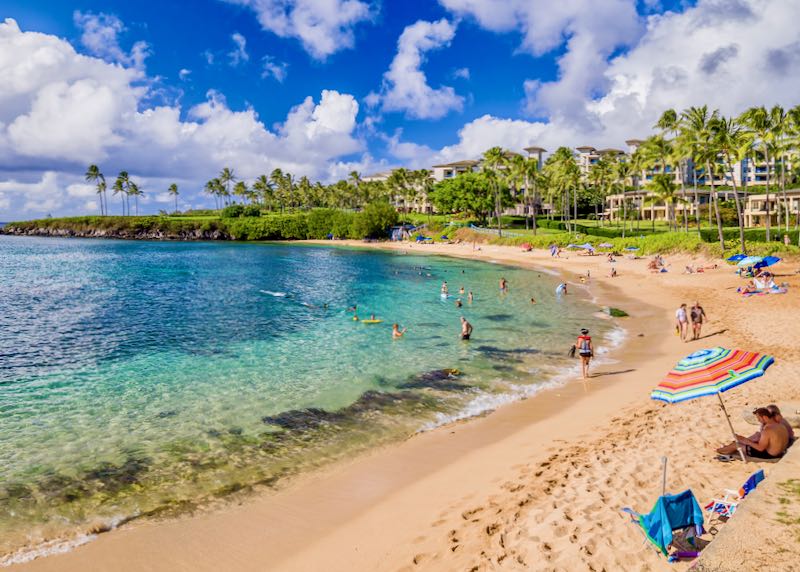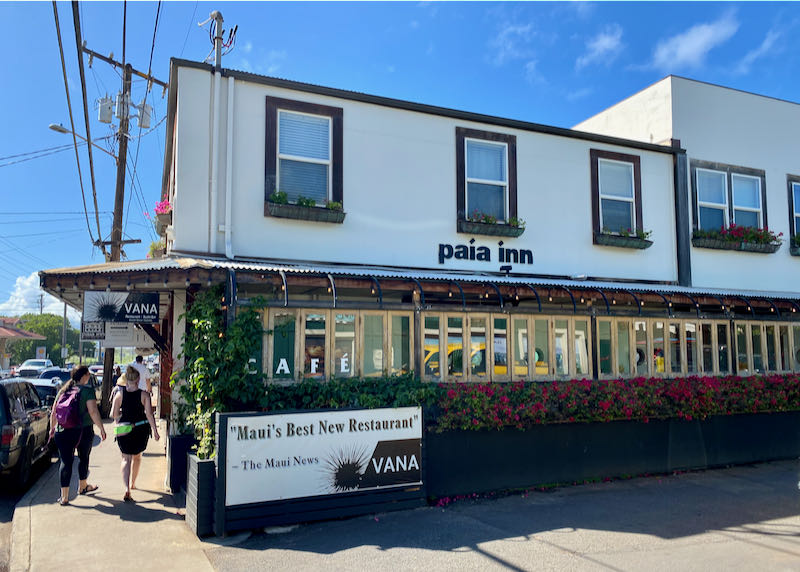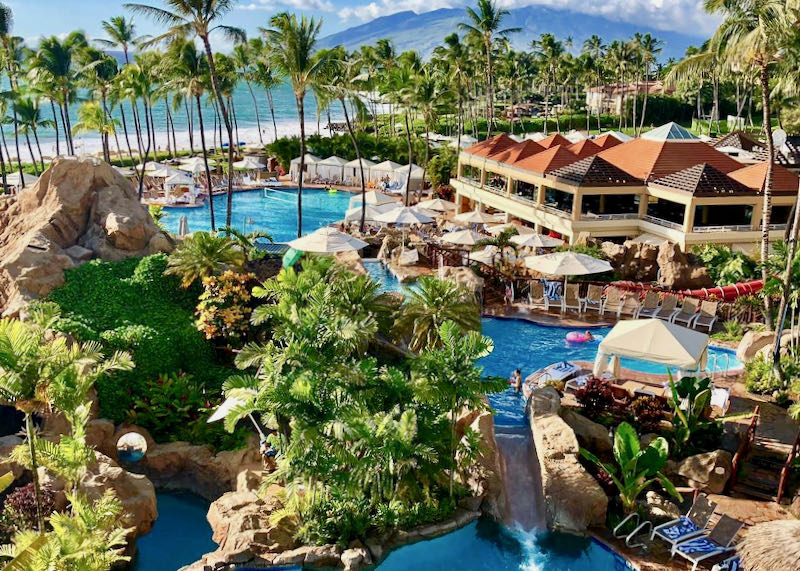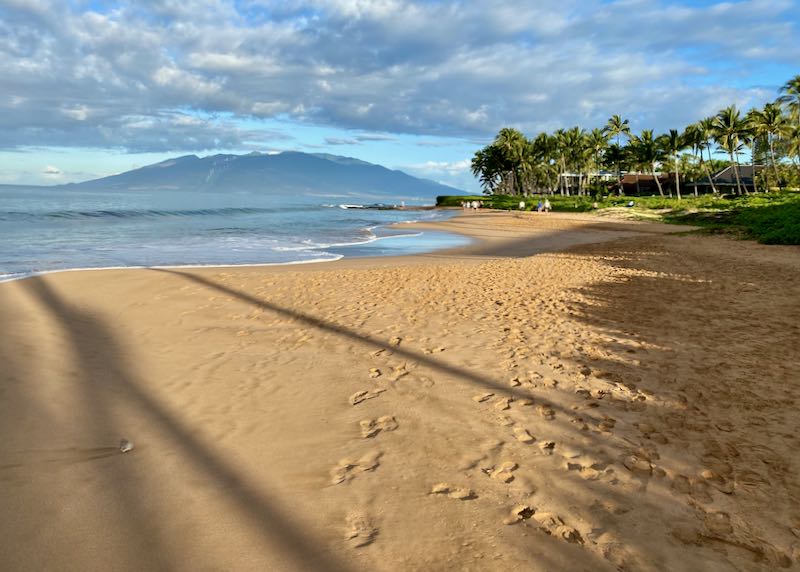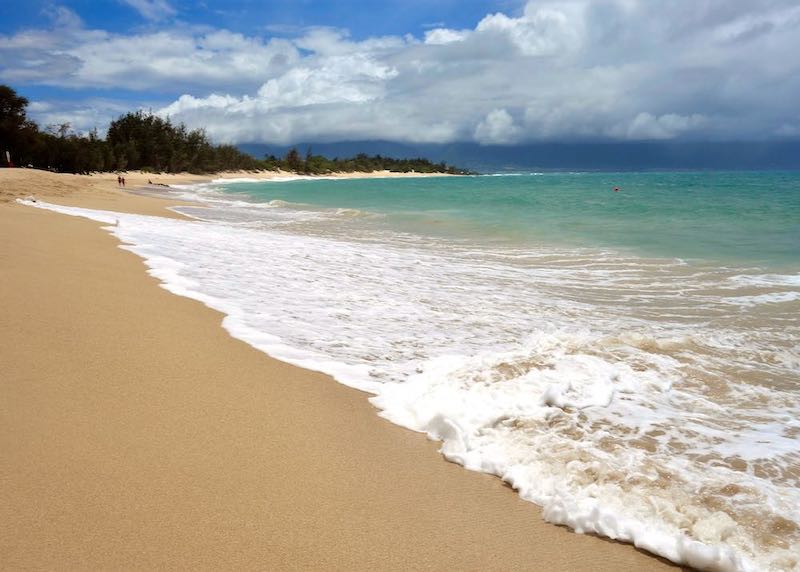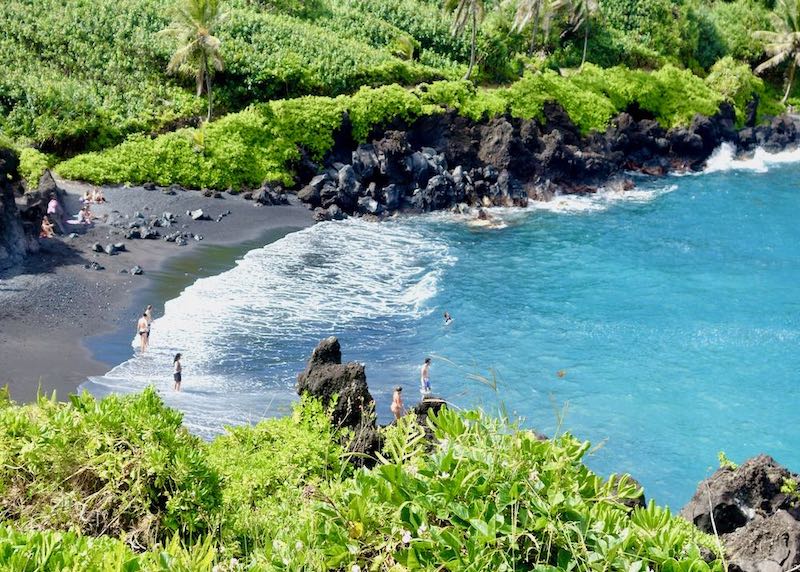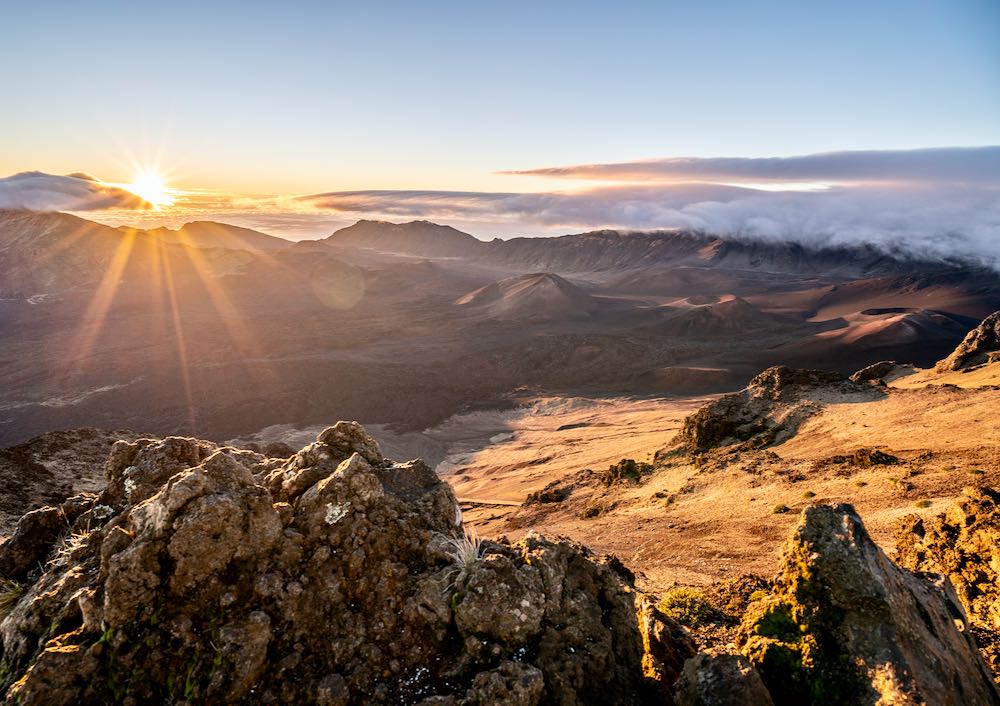By Seattle Dave
My Favorite Hotels in Maui
• Kapalua: Montage
• Kaanapali: Westin
• Kihei: Mana Kai
• Wailea: Four Seasons
• Paia: Paia Inn
• Hana: Hana-Maui Resort
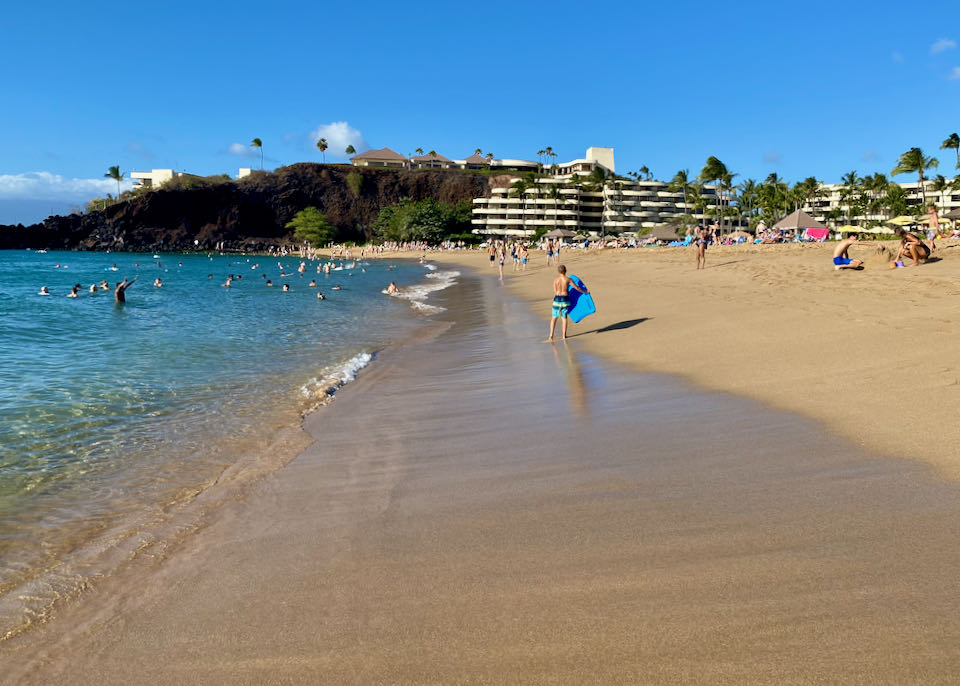
The wonderful beach and sand in front of the OUTRIGGER in Maui. This is a fantastic place to stay for first-time visitors.
The Best Areas to Stay in Maui
Maui consistently ranks among the world’s top island destinations, thanks to its stunning white-sand beaches and clear skies. The diverse landscape includes a waterfall-filled rainforest in the east and a rugged desert in the west. At the island’s heart lies Haleakala, the world’s largest dormant volcano, offering breathtaking sunrise and sunset views and a crater larger than Manhattan. Known as the House of the Sun, it is said that the demigod Maui lassoed the sun from here to lengthen the day.
Visitors to Maui can experience its tropical ecosystem through activities like big wave surfing, coral reef snorkeling, volcano hiking, waterfall swimming, and winter whale watching. The culinary scene highlights fresh, locally sourced ingredients, blending Hawaiian, Polynesian, and pan-Asian flavors across a variety of eateries, from roadside shacks to upscale restaurants. Accommodations primarily consist of luxury beachfront resorts, but boutique hotels, cozy B&Bs, affordable options, and youth hostels can be found throughout the island to suit all budgets.
Though compact, Maui can be broken up into several distinct regions. The vast majority of Maui’s hotels are in West and South Maui. Sun-kissed West Maui is home to the luxury beach resorts of Ka’anapali, Napili, and Kapalua stretching north along the coast. In August 2023, the historic Lahaina town in West Maui was devastated by a fire that will take years to recover from but West Maui is open to tourists. South Maui is home to bustling Kihei town, filled with restaurants and shops, plus the master-planned golf and beach resorts of Wailea (great for Maui first timers) and Makena. Kihei was also affected by the 2023 fires but is open for tourism. Maui’s North Shore is where the rainforest and the scenic Road to Hana begin; its main towns, Paia and Ha’iku, offer a boho vibe, boutique hotels, water sports (especially surfing and windsurfing), and eclectic shops, and local foods. East Maui is where the densest rainforest lies, filled with waterfalls, bamboo forests, and botanical gardens set in between the hairpin turns, sheer cliffs, and single-lane bridges of the Road to Hana, its largest town. The middle of the island, Upcountry, is dominated by the enormous Haleakala Volcano; the least touristy part of Maui, Upcountry is filled with farms, dairies, small villages, and scenic vistas. Central Maui is home to the airport and Kahului, the island’s largest city. Despite its size, Kahului is not a tourist destination, more of a shopping district catering to locals.
The Best Places to Stay in Maui
The fantastic beach in front of the Montage Kapalua Bay Hotel.
- Best Luxury Hotels in Maui
Four Seasons • Grand Wailea • Montage Kapalua Bay- Best Family Hotels in Maui
Grand Wailea • Montage Kapalua Bay • Westin Maui Resort & Spa • Four Seasons • Mana Kai Maui- Best Boutique Hotels in Maui
Andaz Maui at Wailea Resort • Hotel Wailea (adults only) • Hana-Maui Resort- Best 3-Star/4-Star Hotels in Maui
Mana Kai Maui • OUTRIGGER • Maui Seaside Hotel • Paia Inn- Best Maui Hotels Directly on the Beach
Montage Kapalua Bay • Andaz Maui at Wailea Resort • OUTRIGGER • Mana Kai Maui- Top TripAdvisor Hotels (Best Value)
OUTRIGGER • Hyatt Regency Maui Resort & Spa • Wailea Beach ResortBest Areas in Maui for…
The charming Paia Inn fronts the town on one side and the beach on the other.
- Best Beaches in Maui: West Maui, South Maui, North Shore, East Maui
All of Maui is wrapped in incredible beaches, but each area has a different beach style. West Maui and South Maui boast long stretches of white sand with usually moderate waves, great swimming, excellent water sports (especially surfing, bodyboarding, and snorkeling), and whale watching in the winter months. The North Shore offers the best sporting beaches for more experienced surfers, windsurfers, and kitesurfers; waves are enormous in winter and many pro tournaments are held here yearly. East Maui has the quietest, most unspoiled beaches with a mix of black, salt-and-pepper, and red sand beaches – all wonderful for swimming but with few amenities.- Best Places for Sightseeing in Maui: East Maui and Upcountry
East Maui boasts the single most popular attraction on Maui: the Road to Hana. This narrow road winds its way past rainforest, waterfalls, botanical gardens, ancient lava rock temples, and volcanic beaches. Upcountry is home to the Haleakala Crater, a huge shield volcano offering sweeping sunrise and sunset views from its peak.- Best Places for Families in Maui: West Maui, South Maui, North Shore
West Maui and South Maui offer the most family-friendly attractions, restaurants, and beaches with shallow water and gentle waves. Hotels and resorts here feature a wide range of family rooms, suites, and interconnecting rooms, along with active kids’ clubs, spectacular pools, and onsite entertainment, including luaus, barbecues, and beach events. For families who aren’t into large resorts, the North Shore offers a handful of family-friendly hotels, casual restaurants in the main town Paia, and great beaches for beginning swimmers, such as Baby Beach and Baldwin Cove. Ho’okipa Beach Park here is not as good for swimming, but younger kids enjoy exploring its many tide pools, snorkeling, and observing the sea turtles that gather here every evening before sunset.The Grand Wailea in West Maui is a fantastic resort for families.
- Most Romantic Places in Maui: West Maui, South Maui, North Shore, East Maui, Upcountry
Maui is packed with romantic potential in every corner. The north end of West Maui and the south end of South Maui boast the best luxury hotels on the island, some adults-only properties, and many more with adults-only wings or pools. West and South Maui offer the best sunset ocean views toward the islands of Lanai, Moloka’i, and Kaho‘olawe ready to be enjoyed with toes-in-the-sand dining and drinks under the stars. The North Shore offers a few high-end boutique hotels, a laidback vibe, cozy farm-to-table restaurants, and charming towns and beaches meant for evening strolls. East Maui offers the verdant landscape of Hawaiin dreams with remote beaches, secluded waterfall pools, and thick, flowering rainforests. Upcountry charms couples with its rugged volcano views, idyllic farmland, and radiant aloha spirit in each small village.- Best Places for Food and Nightlife in Maui: South Maui, North Shore, Upcountry
Maui is not well-known for nightlife, though in South Maui, there are a few smaller bars on the main street of Kihei. Most fine dining and farm-to-table restaurants will be in the main towns and resorts of West and South Maui, with the notable exception of Mama’s Fish House on the North Shore. Generally, the North Shore and Upcountry offer more casual, hearty fare, though the emphasis on freshness and eating local means the food in either area is remarkably flavorful.- Best Places for a Local Vibe in Maui: North Shore, Upcountry, East Maui
For a more authentic feel, skip the mega-resorts of West and South Maui and head to the North Shore, East Maui, or Upcountry, where you’re more likely to interact with locals than with tourists. Upcountry is the least touristy area. There are few hotels here and most of the shops and restaurants in town cater to local tastes and needs with an excellent farmers’ market, a few general stores, and charming little cafes. East Maui offers a taste of Old Hawaii; most tourists here drive the Road to Hana, then turn right back around; few remain overnight or longer to explore Hana, its cheerful food stands, small beaches, or cultural sights. The North Shore gets more visitors than East Maui or Upcountry but is devoid of large resorts, which allows the area to maintain its artsy, hippie energy.
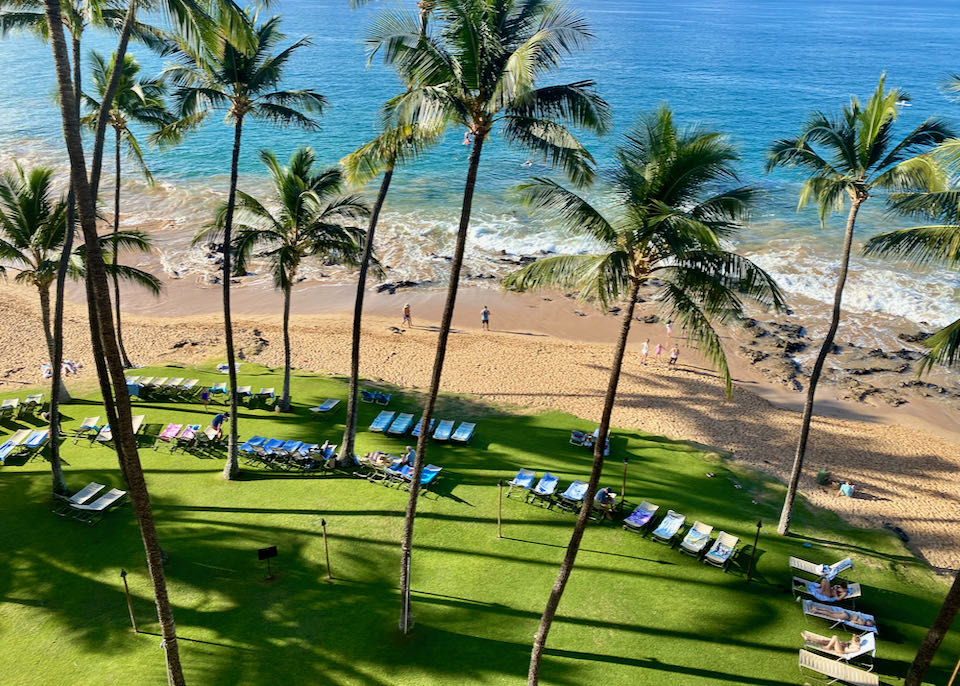
The Mana Kai Maui. One of my favorite hotels in Maui. Great value and sits on a wonderful stretch of sand. Easy walk to both Wailea (along the beach) and Kihei (sidewalk or beach path). One and two-bedroom apartments have full kitchens, balconies, and sunset views.
- Safest Areas of Maui
Overall, Maui is an incredibly safe place to visit, with a lower than average crime rate versus the U.S. national average. Violence and property crimes are low on average here, but the safest areas of Maui are Upcountry, South Maui, and the North Shore.- Unsafe Areas of Maui
Maui is a safe place to visit, but don’t let the gorgeous scenery fool you. The most dangerous things here are the ocean itself, especially the North Shore beaches whose large waves can easily sweep away inexperienced swimmers. The Road to Hana is narrow and fraught with blind curves and single-lane bridges, so exercise caution when driving. Though Maui is generally safe, crime can happen anywhere. Most crime in Maui is property crime, rather than violent crime, usually in the form of car break-ins and theft. Be sure to secure all valuables when parking your car at a beach, scenic lookout point, or in any downtown areas, especially at night. The most dangerous town in Maui is Wailuku, where travelers don’t have any reason to visit; most of the crime in Wailuku is in Happy Valley, a former red-light district.The Best Places in Maui for Tourists
1. South Maui
South Maui, which wraps around the southwest coast, is the driest, sunniest part of the island. Beginning in the small, harbor town Ma’alaea, South Maui curves around through busy Kihei, runs down through the luxury resorts of Wailea and Makena, and continues until the road peters out at the rugged lava fields spilling into La Perouse Bay. All areas here offer soft sand beaches, water sports centers, and excellent restaurants. Along with West Maui, South Maui is one of the best spots for whale watching, with tours departing several times daily, along with snorkel and diving tours to the marine preserve of the Molokini caldera. Despite the throngs of tourists visiting Ma’alaea and Kihei, these beachfront towns are still home to local families who have lived here for generations. Wailea and Makena, on the other hand, are both master-planned resorts filled with upscale hotels, golf courses, and fine dining restaurants. There’s a wonderful seafront pedestrian walk that runs in front of all the Wailea resorts to the fantastic Mokapu Beach. The Mana Kai Maui sits on the northern end of this amazing stretch of sand – and it’s much cheaper than the 5-star Wailea resorts but with similar (or better) beach access.
- Best Hotels: Grand Wailea • Four Seasons Wailea • Andaz Maui at Wailea Resort • Hotel Wailea (adults only) • Mana Kai Maui
2. West Maui
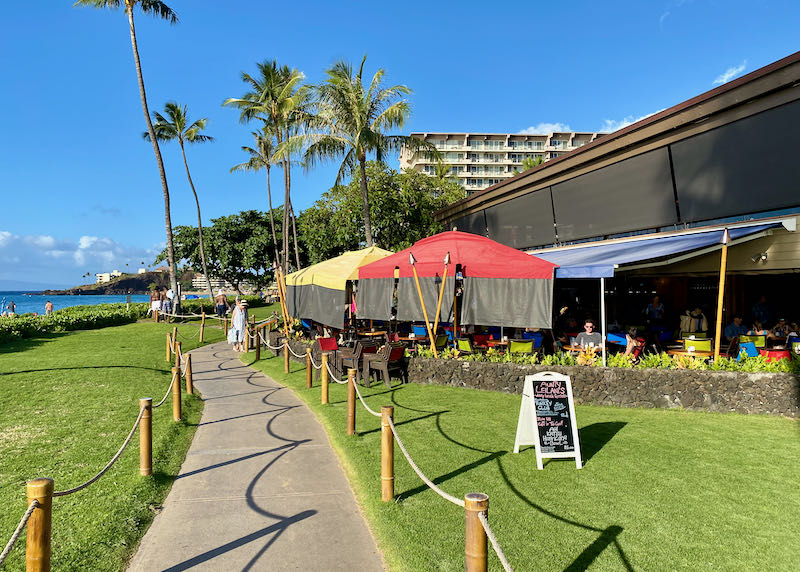
Heading north along the coastline leads to the luxury beach resorts of Ka’anapali, Napili, Kapalua, and more. Ka’anapali, Hawaii’s first planned resort, boasts 5 km of white sand beach interrupted by the cliff of Black Rock, where the legendary last chief of Maui, Kahekili, leaped into the ocean in a show of strength. Ka’anapali is also home to the upscale outdoor shopping mall Whalers Village, located on the beach, surrounded by restaurants, and steps from the Westin Maui Resort & Spa and OUTRIGGER. Napili is the quietest area in this otherwise active shoreline; snorkel with sea turtles in Napili Bay, sample local beers at Maui Brewing Company, and visit the farmers market on Wednesday mornings. Immediately north, Kapalua is among the most exclusive resort areas of Maui with two prestigious golf courses, a crescent-shaped bay with excellent snorkeling, and top-notch dining. Inland are the West Maui Mountains with ancient trails, lava formations, lush vegetation, and sweeping views. Along with South Maui, West Maui is one of the best places for whale watching in the winter months.
The first capital of the Hawaiian Kingdom, Lahaina, was rich with historic sites, but most were lost to the fire. The town was a retreat for royalty in the early 1800s. By the mid-1800s, it was a lively whaling town where about 400 ships anchored, including one employing Herman Melville. But Maui’s oldest banyan tree survived the fire and is a symbol of perseverance.
- Best Hotels: Montage Kapalua Bay • Westin Maui Resort & Spa • OUTRIGGER
3. North Shore
Maui’s North Shore is a rugged string of white sand beaches and easygoing towns at the beginning of the rainforest. The area is best known for its variety of unspoiled, natural beaches. Baldwin Beach is the widest, sandiest, most popular beach here, with lifeguards and basic facilities. Its western and eastern ends, called Baby Beach and Baldwin Cove respectively, offer calm, shallow water for beginning swimmers, while the main beach is popular for bodyboarding and surfing. Ho’okipa Beach is considered the top windsurfing beach in the world with competitions held here regularly; at the far eastern end, sea turtles come to shore nightly to rest – up to 40 at a time. Pe’ahi Beach AKA Jaws is the top surfing beach; several major surf competitions are held here in the winter months when swells reach over 18 meters high. Baldwin, Ho’okipa, and Lanes Beaches are all suitable for kitesurfing, though most people head to nearby Kanaha Beach (AKA Kite Beach).There are no large resorts or tourist attractions on the North Shore. Instead, you’ll find a handful of boutique hotels and B & Bs, casual diners, a farmers’ market, surf shops, and hundred-year-old Buddhist temples in effortlessly cool Paia town. East of Paia and deeper into the rainforest is the rustic village Ha’iku, surrounded by farmland, hiking trails with waterfalls, and featuring a couple of old pineapple canneries, converted into boutique shopping centers. More centrally located than so-called Central Maui, the North Shore is an ideal perch for active travelers who plan to visit the entire island. From the North Shore, it’s a straight shot for 30 minutes to Kihei, about 45 minutes to Lahaina, an hour to the peak of Haleakala, and about an hour and a half to Hana if you drive straight through (NB: no one drives straight through – the whole point of the drive is to stop and take in the scenery).
- Best Hotels: Inn at Mama’s Fish House • Paia Inn
4. East Maui
Bordering the North Shore and Upcountry, East Maui is a wonderland of rainforest and rainbows, waterfalls pouring into freshwater pools, and volcanic, black sand beaches. East Maui on the windward (rainy) coast is largely undeveloped. Its main town, Hana, is accessible by one narrow road, the celebrated Road to Hana, which twists 600 hairpin turns above sheer cliffs blanketed in green, crosses 50 single-lane bridges, and passes by nature preserves, hiking trails, and humble food shacks. Hana itself is one of the most remote communities in all of Hawaii with only a few restaurants plus several food trucks), one hotel (plus a few vacation homes, and a grocery store. On the Road to Hana, find Kahanu Garden, a tropical botanical garden and home to Pi’ilanihale Heiau (a Hawaiian, lava rock temple; the largest manmade structure in Polynesia) and Waianapanapa State Park (lava tubes, sea caves, blowhole, and the best black sand beach in the state – pictured above). Beyond Hana on the same road is the Oheo Gulch (home of the Seven Sacred Pools and the Pipiwai Trail) and Wailua Falls (25-meter waterfall, one of the best in Hawaii). The beaches of East Maui are world-renowned with Hamoa Beach topping the list of best-loved with its silky salt-and-pepper sand (a blend of black lava and white coral) a favorite of Ernest Hemingway, James Michener, and Oprah Winfrey. Hana is also home to Kaihalulu Beach, a red sand beach with sparkling, blue water accessible by a steep hiking trail. East Maui is ideal for active, outdoorsy days and relaxing, romantic evenings; those used to nightlife or resort entertainment may find this area too isolated.
- Best Hotels: Hana-Maui Resort • Hana Kai Resort
5. Upcountry
Climbing the sides of the Haleakala shield volcano, the aptly named Upcountry is a mostly rural area with farms, ranches, and a few villages circling the crater. The leeward side of the volcano (western slope) is a desert, while the windward side (eastern slope) is covered in rainforest and waterfalls. The peak of Haleakala offers panoramic sunrise and sunset views over Maui and is one of the island’s most loved attractions. Even those staying in distant Kapalua or Hana will make the long drive while it’s still dark out to catch the legendary sunrise from the summit. Historically, Upcountry was paniolo country. Paniolo are Hawaiian cowboys, and their traditions began decades before those of the more famous Wild West cowboys of mainland America. Though it’s not super common to see paniolo outside of the 4th of July rodeo these days, the main town Makawao retains much of the cowboy feel in the architectural style of the main storefronts. Makawao is the largest town in Upcountry and is better known for its galleries, boutiques, artists’ workshops (glass, sculpture, painting), and T. Komoda Bakery (est. 1916; get there early – they often sell out by 10:00 a.m.). If you’re lucky enough to be in Upcountry at the right time, the lei shop, Haku Maui, offers lei-making classes once every few weeks. The second-largest town here is Kula. Even more rustic than Makawao, the fertile Kula region supplies much of the produce, meat, and dairy served in Maui’s finest farm-to-table restaurants. Tours are offered at many farms here, including Surfing Goat Dairy, Ali’i Kula Lavender Farm, O’o Farm (coffee and Maui onions), and more. Of course, there is also an excellent farmers market here, held weekly on Saturday mornings from 7:00 to 11:00. Unexpected offerings in Upcountry include a unique winery (blending grapes with pineapple) and a vodka distillery.
- Best Hotels: Kula Lodge • Lumeria Maui
